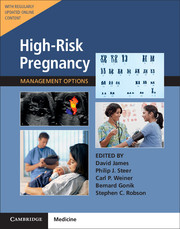Book contents
- Frontmatter
- Contents
- List of Contributors
- Preface
- Section 1 Prepregnancy Problems
- Section 2 Early Prenatal Problems
- Section 3 Late Prenatal – Fetal Problems
- Section 4 Problems Associated with Infection
- Section 5 Late Pregnancy – Maternal Problems
- Section 6 Late Prenatal – Obstetric Problems
- 52 Abdominal Pain in Pregnancy
- 53 Nonmalignant Gynecology in Pregnancy
- 54 Bleeding in Late Pregnancy
- 55 Multiple Pregnancy
- 56 Threatened and Actual Preterm Labor
- 57 Prelabor Rupture of the Membranes
- 58 Breech Presentation, Unstable Lie, Malpresentation, and Malpositions
- 59 Prolonged Pregnancy
- 60 Induction of Labor and Termination of the Previable Pregnancy
- 61 Dysfunctional Labor
- 62 Shoulder Dystocia
- 63 Fetal Compromise in Labor
- 64 Neuraxial Analgesia and Anesthesia in Obstetrics
- 65 Perineal Repair and Pelvic Floor Injury
- 66 Assisted Vaginal Delivery
- 67 Delivery After Previous Cesarean Section
- 68 Cesarean Section
- Section 7 Postnatal Problems
- Section 8 Normal Values
- Index
62 - Shoulder Dystocia
from Section 6 - Late Prenatal – Obstetric Problems
- Frontmatter
- Contents
- List of Contributors
- Preface
- Section 1 Prepregnancy Problems
- Section 2 Early Prenatal Problems
- Section 3 Late Prenatal – Fetal Problems
- Section 4 Problems Associated with Infection
- Section 5 Late Pregnancy – Maternal Problems
- Section 6 Late Prenatal – Obstetric Problems
- 52 Abdominal Pain in Pregnancy
- 53 Nonmalignant Gynecology in Pregnancy
- 54 Bleeding in Late Pregnancy
- 55 Multiple Pregnancy
- 56 Threatened and Actual Preterm Labor
- 57 Prelabor Rupture of the Membranes
- 58 Breech Presentation, Unstable Lie, Malpresentation, and Malpositions
- 59 Prolonged Pregnancy
- 60 Induction of Labor and Termination of the Previable Pregnancy
- 61 Dysfunctional Labor
- 62 Shoulder Dystocia
- 63 Fetal Compromise in Labor
- 64 Neuraxial Analgesia and Anesthesia in Obstetrics
- 65 Perineal Repair and Pelvic Floor Injury
- 66 Assisted Vaginal Delivery
- 67 Delivery After Previous Cesarean Section
- 68 Cesarean Section
- Section 7 Postnatal Problems
- Section 8 Normal Values
- Index
Summary
Introduction
Shoulder dystocia is defined as a vaginal cephalic delivery that requires additional obstetric maneuvers to deliver the fetus after gentle traction has failed. It occurs when either the anterior shoulder impacts behind the maternal symphysis or, less commonly, the posterior shoulder impacts over the sacral promontory. Evidence-based algorithms for the management of shoulder dystocia recommend resolution maneuvers designed to improve the relative dimensions of the maternal pelvis (McRoberts’ position and all-fours position), reduce the diameter of the fetal shoulders (suprapubic pressure and delivery of the posterior arm) and/or move the fetal shoulders into a wider pelvic diameter (suprapubic pressure and internal rotational maneuvers).
There can be significant perinatal morbidity and mortality associated with shoulder dystocia, most notably brachial plexus injury. However, recent data suggest that neonatal outcomes can be improved through multiprofessional simulation training.
Definition and Incidence
Shoulder dystocia has traditionally been defined on both sides of the Atlantic as a vaginal cephalic delivery that requires additional obstetric maneuvers to deliver the fetus after gentle or diagnostic traction has failed. However, this is a very subjective definition, and one UK judge has observed that this is a slightly circular definition because it requires the diagnosis to have been made before the defining additional maneuvers are employed.
The American College of Obstetricians and Gynecologists (ACOG) practice bulletin for shoulder dystocia recommends that the “turtle sign,” or chin retraction, may assist in the diagnosis of shoulder dystocia. However, the turtle sign is not regarded as diagnostic by itself in the Royal College of Obstetricians and Gynaecologists (RCOG) guidance.
As well as using the standard shoulder dystocia definition of additional maneuvers after the diagnostic traction has failed, the most recent RCOG guideline now recommends the use of a more objective diagnosis: a time interval of > 60 seconds from delivery of the head to delivery of the body. However, even with this definition, there is a caveat that waiting for a contraction following the birth of the fetal head may prolong the head-to-body delivery interval without there being any difficulty with delivery of the shoulders.
- Type
- Chapter
- Information
- High-Risk Pregnancy: Management OptionsFive-Year Institutional Subscription with Online Updates, pp. 1776 - 1788Publisher: Cambridge University PressFirst published in: 2017

